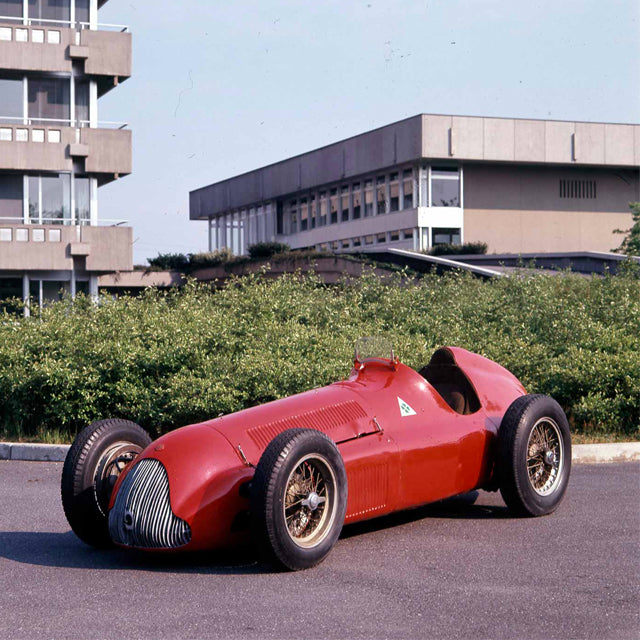

The 158/159 was born in 1937, toward the end of Enzo Ferrari's tenure at Alfa Romeo. At the time, Mercedes and Auto Union dominated the world of Grand Prix racing, with Alfa Romeo and Maserati trailing behind as outmoded also-rans (Bugatti had withdrawn altogether by this time). As Alfa Romeo's efforts to compete against the Germans was proving fruitless, Scuderia Ferrari made the decision to compete in the "Voiturettes" class ("voiturette" being French for "small car"), a decision seen by many in the racing press of the time as an admission of defeat. Cars in this class, however, were restricted to 1.5 liters of displacement and Enzo Ferrari hoped that he could beat the Germans by taking advantage of these restrictions. He then went to Alfa Romeo's engineers and asked them build him a car.
What resulted was the 158, designed in Milan by Gioacchino Colombo but built at the Scuderia headquarters in Modena. An initial quartet of four cars (known as "series one spec") was built with 1.5-liter, supercharged straight-8 engines producing 180 horsepower at 6500 RPM. The car had a then-conventional design which featured a longeron frame and independent suspension. The body color was – can you guess? – red.
Soon thereafter, however, Enzo Ferrari and Alfa Romeo parted ways. The cars were then shipped back to Milan, where their engines were tweaked to produce an additional 15 horsepower and 1000 RPM. Back on the track, Luigi Villorisi wasted no time in proving these cars a success by taking home the Coppa Ciano in Livorno.
Having tasted victory, Alfa Romeo kicked off 1939 by producing an additional four 158s. These new models featured an updated lubrication system and crankshaft, as well as new roller bearings and bigger supercharger rotors. With these upgrades, the cars now pushed 225 horsepower at 7500 RPM. At the Tripoli Grand Prix in May, 1939, Villoresi once again got behind the wheel but was unable to defeat the Mercedes W165s, finishing third behind a pair of the Benzes. As it turned out, this was the last race for Mercedes in the Voiturettes series. With Mercedes out of the picture, the Alfa 158 went on to take the trophy in the Coppa Acerbo and the Grand Prix events at Livorno and Berna.



By the time the Tripoli Grand Prix rolled around again in 1940, Alfa Romeo's competition was thin: Alfa took home 1st, 2nd, 3rd, and 6th place finishes in the event.
And then came World War II. Racing stopped, men went off to war – many of them never to return – and the 158s were stashed away in pig sheds while the world fell to pieces around them.
By the time the war ended, Europeans were itching to once again cut loose and enjoy themselves, and this pent up desire for fun included a demand for motor racing. In 1946, then, they started pulling old race cars like the 158/159s out of barns and warehouses and started prepping them for a return to the track.
The first major race of that year for the Alfa Romeo team was the Saint Cloud Grand Prix in Paris, where they failed to finish. By the time the next race, in Geneva, rolled around, however, Alfa Romeo had learned its lesson. Equipped with a new and improved 2-stage Roots supercharger, Nino Farina piloted his car to the winner's circle.
From 1947 through 1950, Alfa Romeo made incremental improvements to their platform as the company moved toward dominance: an improved cooling system, a modified supercharger, a few adjustments to the exhaust system, and a lower stance to help in cornering led to wins in the Grand Prix events at Turin and Monza. In 1950, Alfa Romeo took home its first World Championship.
And then they did it again in 1951, this time with Juan Manuel Fangio at the wheel of a 159. In a later interview with the Italian magazine Quattroruote, Fangio was quoted as describing the 150 as "the most beautiful car I have ever driven."
This car, and its 158 predecessors, also stands as among the most beautiful in all of Alfa Romeo's storied history.
Thank you to "Alfa Romeo Automobilismo Storico, Centro Documentazione (Arese, Milano)” for the pictures.






















































